2009 NISSAN LATIO clutch
[x] Cancel search: clutchPage 32 of 4331
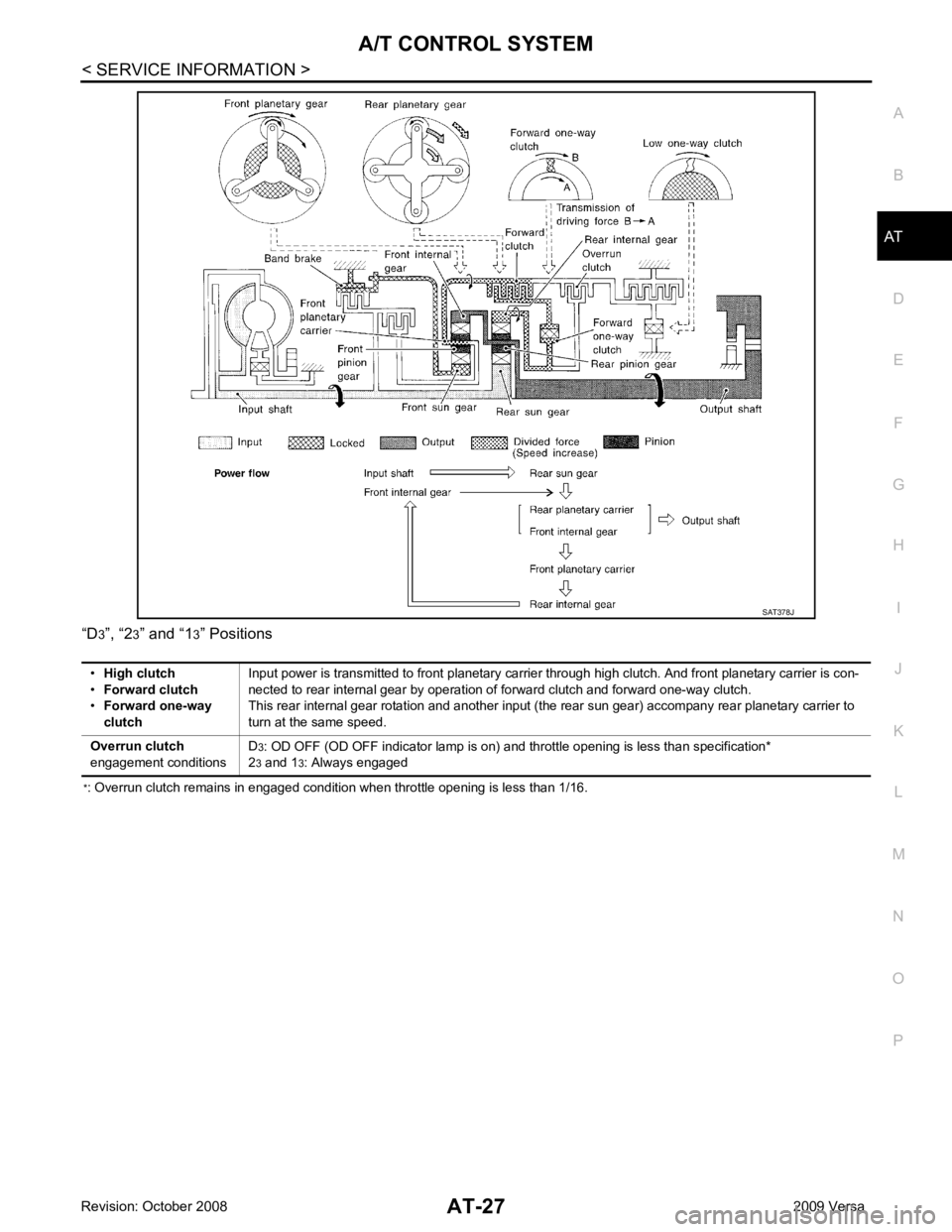
AT
N
O P
“D
3
”, “2 3” and “1 3” Positions
* : Overrun clutch remains in engaged condition when throttle opening is less than 1/16.
Page 38 of 4331
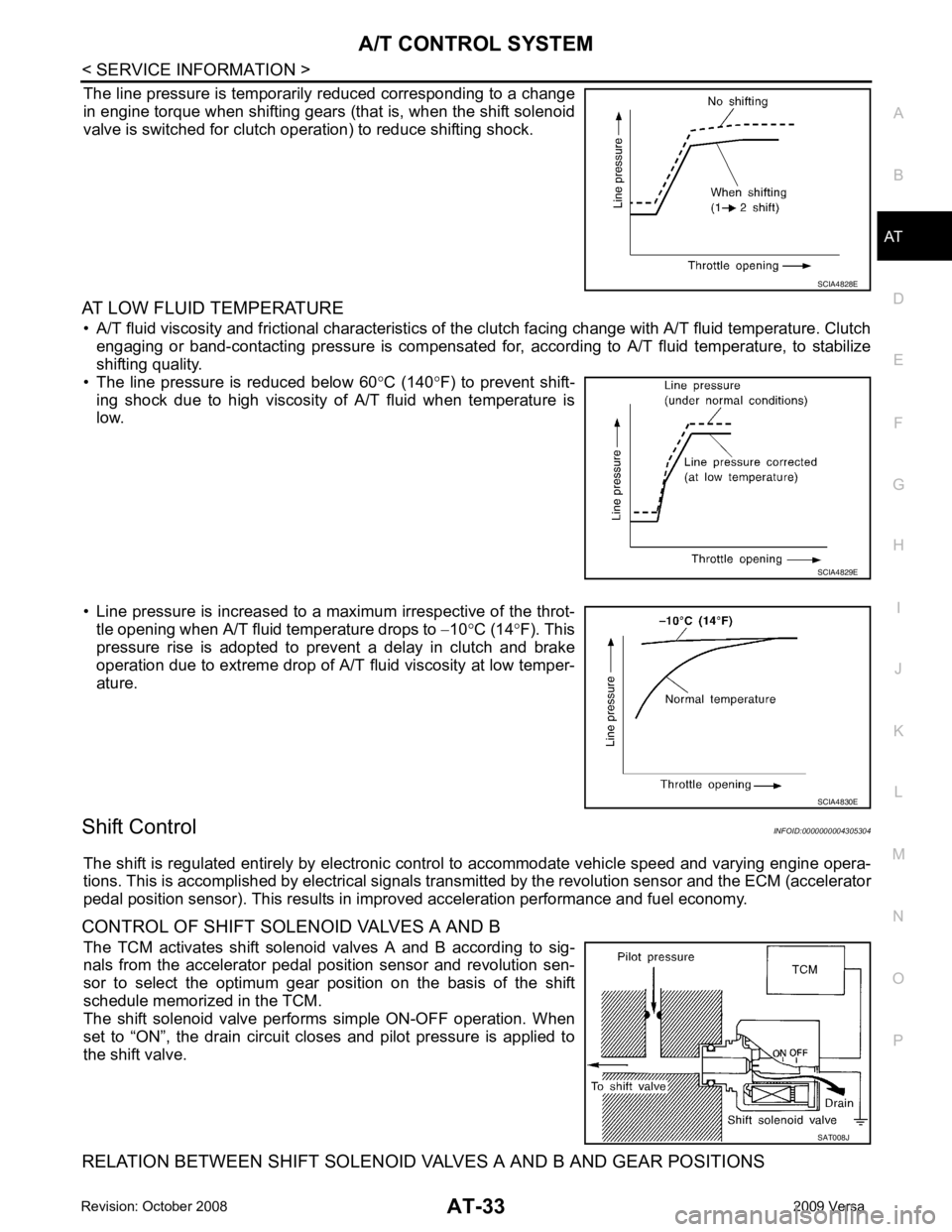
AT
N
O P
The line pressure is temporarily reduced corresponding to a change
in engine torque when shifting gears (that is, when the shift solenoid
valve is switched for clutch operation) to reduce shifting shock.
AT LOW FLUID TEMPERATURE • A/T fluid viscosity and frictional characteristics of t he clutch facing change with A/T fluid temperature. Clutch
engaging or band-contacting pressure is compensated for, according to A/T fluid temperature, to stabilize
shifting quality.
• The line pressure is reduced below 60 °C (140 °F) to prevent shift-
ing shock due to high viscosity of A/T fluid when temperature is
low.
• Line pressure is increased to a maximum irrespective of the throt- tle opening when A/T fluid temperature drops to −10 °C (14 °F). This
pressure rise is adopted to prevent a delay in clutch and brake
operation due to extreme drop of A/T fluid viscosity at low temper-
ature.
Shift Control INFOID:0000000004305304
The shift is regulated entirely by electronic cont rol to accommodate vehicle speed and varying engine opera-
tions. This is accomplished by electrical signals trans mitted by the revolution sensor and the ECM (accelerator
pedal position sensor). This results in improved acceleration performance and fuel economy.
CONTROL OF SHIFT SOLENOID VALVES A AND B The TCM activates shift solenoid valves A and B according to sig-
nals from the accelerator pedal position sensor and revolution sen-
sor to select the optimum gear pos ition on the basis of the shift
schedule memorized in the TCM.
The shift solenoid valve performs simple ON-OFF operation. When
set to “ON”, the drain circuit closes and pilot pressure is applied to
the shift valve.
RELATION BETWEEN SHIFT SOLENOID VALVES A AND B AND GEAR POSITIONS SAT008J
Page 40 of 4331
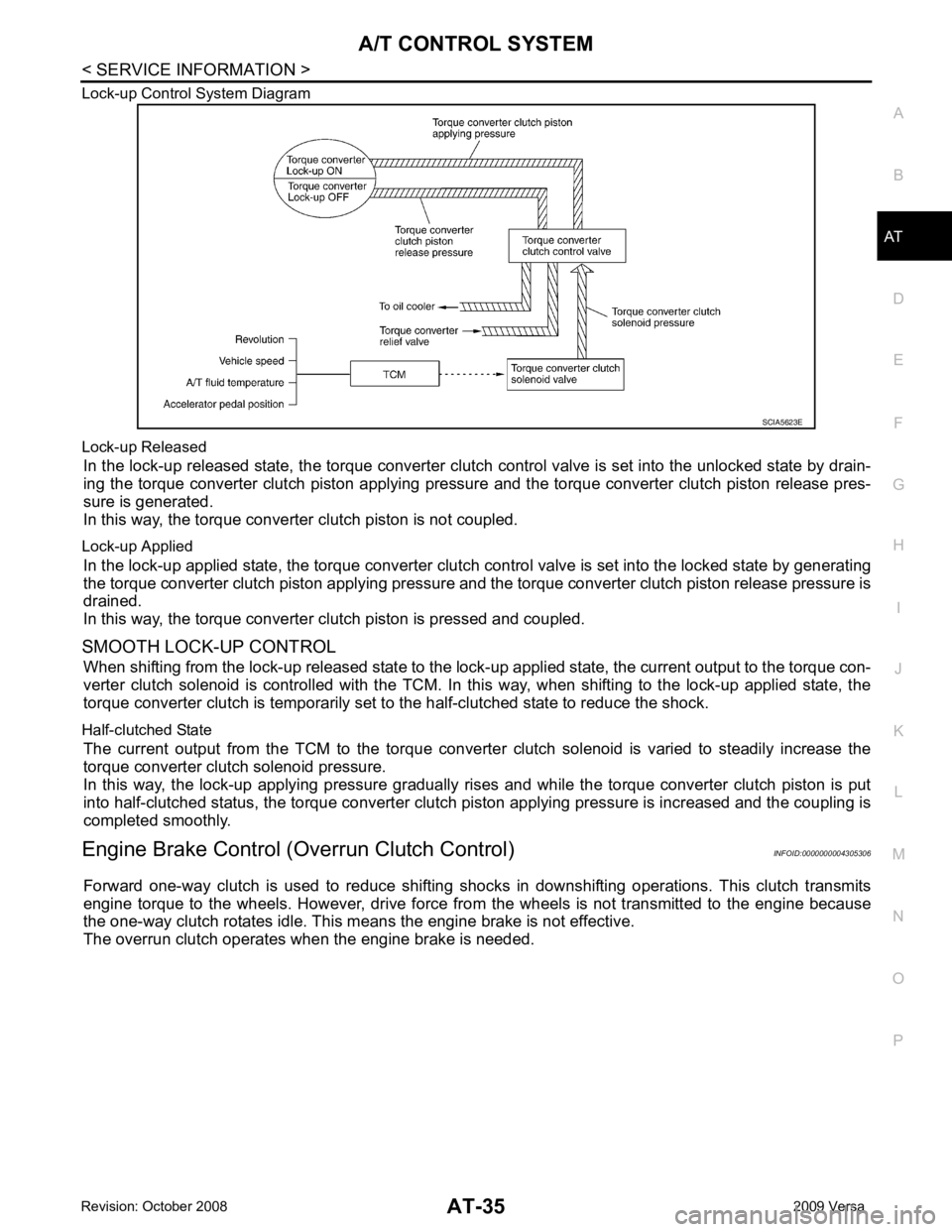
AT
N
O P
Lock-up Control System Diagram
Lock-up Released In the lock-up released state, the torque converter clutch control valve is set into the unlocked state by drain-
ing the torque converter clutch piston applying pressure and the torque converter clutch piston release pres-
sure is generated.
In this way, the torque converter clutch piston is not coupled.
Lock-up Applied In the lock-up applied state, the torque converter clutch control valve is set into the locked state by generating
the torque converter clutch piston applying pressure and t he torque converter clutch piston release pressure is
drained.
In this way, the torque converter clutch piston is pressed and coupled.
SMOOTH LOCK-UP CONTROL When shifting from the lock-up released state to the lock- up applied state, the current output to the torque con-
verter clutch solenoid is controlled with the TCM. In this way, when shifting to the lock-up applied state, the
torque converter clutch is temporarily set to the half-clutched state to reduce the shock.
Half-clutched State The current output from the TCM to the torque converte r clutch solenoid is varied to steadily increase the
torque converter clutch solenoid pressure.
In this way, the lock-up applying pressure gradually rises and while the torque converter clutch piston is put
into half-clutched status, the torque converter clutch piston applying pressure is increased and the coupling is
completed smoothly.
Engine Brake Control (Overrun Clutch Control) INFOID:0000000004305306
Forward one-way clutch is used to reduce shifting shoc ks in downshifting operations. This clutch transmits
engine torque to the wheels. However, drive force fr om the wheels is not transmitted to the engine because
the one-way clutch rotates idle. This means the engine brake is not effective.
The overrun clutch operates when the engine brake is needed.
Page 42 of 4331

AT
N
O P
Control Valve
INFOID:0000000004305307
FUNCTION OF CONTROL VALVES
Centrifugal Cancel Mechanism INFOID:0000000004305308
FUNCTION The centrifugal cancel mechanism is a mechanism to c ancel the centrifugal hydraulic pressure instead of the
conventional check balls. It cancels the centrifugal hy draulic pressure which is generated as high clutch drum
rotates, and it allows for preventing high clutch from dragging and for providing stable high clutch piston press-
ing force in all revolution speeds.
STRUCTURE/OPERATION Valve name Function
Pressure regulator valve, plug and sleeve
plug Regulates oil discharged from the oil pump to provide optimum line pressure for all driving
conditions.
Pressure modifier valve and sleeve Used as a signal supplementary valve to the pressure regulator valve. Regulates pres- sure-modifier pressure (signal pressure) which controls optimum line pressure for all driv-
ing conditions.
Pilot valve Regulates line pressure to maintain a constant pilot pressure level which controls lock-up mechanism, overrun clutch, shift timing.
Accumulator control valve Regulates accumulator back-pressure to pressure suited to driving conditions.
Manual valve Directs line pressure to oil circuits corresponding to select positions. Hydraulic pressure drains when the shift lever is in Neutral.
Shift valve A Simultaneously switches three oil circuits using output pressure of shift solenoid valve A to meet driving conditions (vehicle speed, throttle opening, etc.).
Provides automatic downshifting and upshifting (1st → 2nd → 3rd → 4th gears/4th → 3rd
→ 2nd → 1st gears) in combination with shift valve B.
Shift valve B Simultaneously switches two oil circuits using output pressure of shift solenoid valve B in relation to driving conditions (vehicle speed, throttle opening, etc.).
Provides automatic downshifting and upshifting (1st → 2nd → 3rd → 4th gears/4th → 3rd
→ 2nd → 1st gears) in combination with shift valve A.
Overrun clutch control valve Switches hydraulic circuits to prevent engagement of the overrun clutch simultaneously with application of the brake band in D4. (Interlocking occurs if the overrun clutch engages
during D 4.)
1st reducing valve Reduces low & reverse brake pressure to dampen engine-brake shock when downshift- ing from the 1st position 12 to 1 1.
Overrun clutch reducing valve Reduces oil pressure directed to the overrun clutch and prevents engine-brake shock. In the 1st and 2nd positions, line pressure acts on the overrun clutch reducing valve to
increase the pressure-regulating point, with resultant engine brake capability.
Torque converter relief valve Prevents an excessive rise in torque converter pressure.
Torque converter clutch control valve, plug
and sleeve Activates or inactivates the lock-up function.
Also provides smooth lock-up through transient application and release of the lock-up
system.
1-2 accumulator valve and piston Lessens the shock find when the 2nd gear band servo contracts, and provides smooth shifting.
3-2 timing valve Switches the pace that oil pressure is released depending on vehicle speed; maximizes the high clutch release timing, and allows for soft downshifting.
Shuttle valve Determines if the overrun clutch solenoid valve should control the 3-2 timing valve or the overrun clutch control valve and switches between the two.
Cooler check valve At low speeds and with a small load when a little heat is generated, saves the volume of cooler flow, and stores the oil pressure for lock-up.
Page 48 of 4331
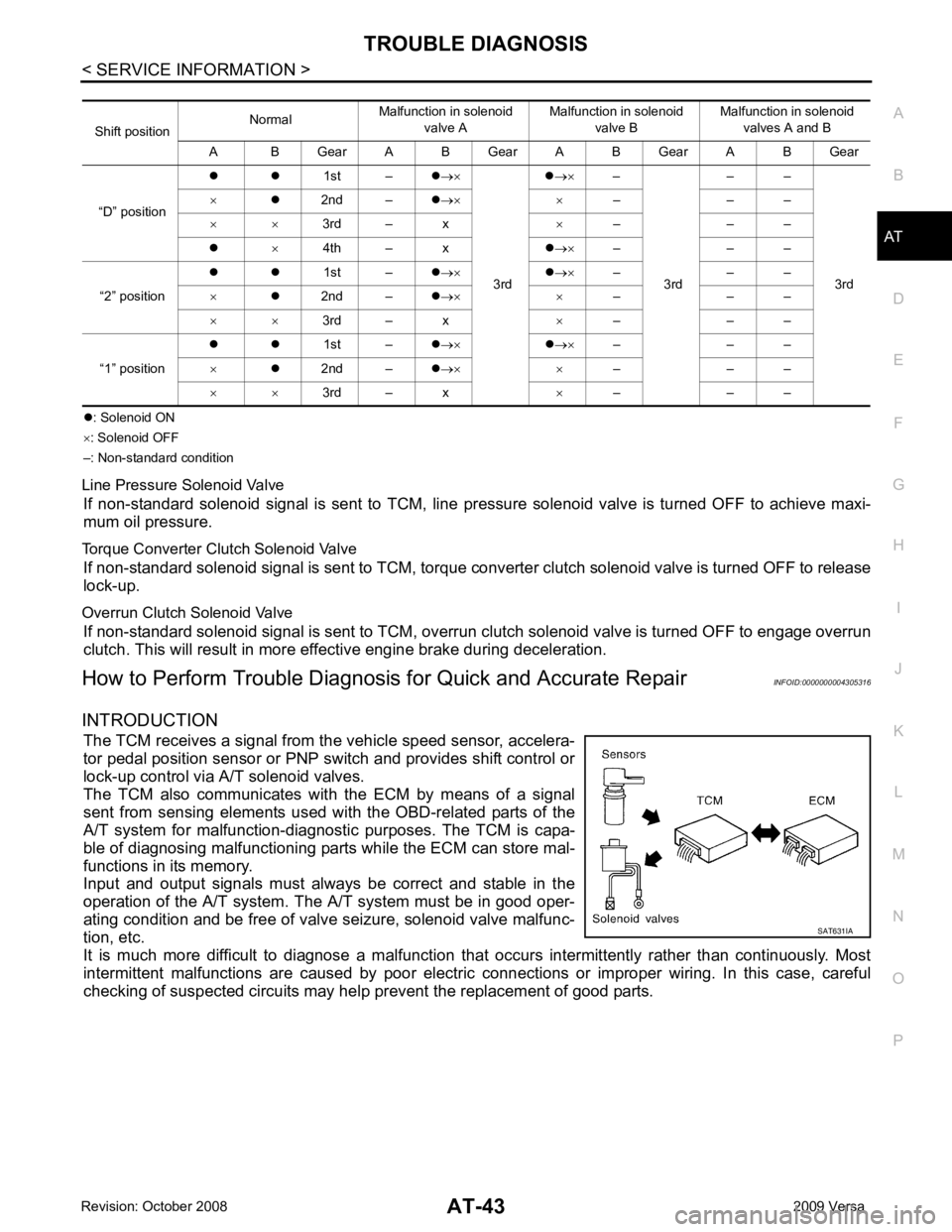
AT
N
O P
�z
: Solenoid ON
× : Solenoid OFF
–: Non-standard condition
Line Pressure Solenoid Valve If non-standard solenoid signal is sent to TCM, line pre ssure solenoid valve is turned OFF to achieve maxi-
mum oil pressure.
Torque Converter Clutch Solenoid Valve If non-standard solenoid signal is sent to TCM, torque conv erter clutch solenoid valve is turned OFF to release
lock-up.
Overrun Clutch Solenoid Valve If non-standard solenoid signal is sent to TCM, overr un clutch solenoid valve is turned OFF to engage overrun
clutch. This will result in more effective engine brake during deceleration.
How to Perform Trouble Diagnosis for Quick and Accurate Repair INFOID:0000000004305316
INTRODUCTION The TCM receives a signal from the vehicle speed sensor, accelera-
tor pedal position sensor or PNP switch and provides shift control or
lock-up control via A/T solenoid valves.
The TCM also communicates with the ECM by means of a signal
sent from sensing elements used wit h the OBD-related parts of the
A/T system for malfunction-diagnostic purposes. The TCM is capa-
ble of diagnosing malfunctioning parts while the ECM can store mal-
functions in its memory.
Input and output signals must always be correct and stable in the
operation of the A/T system. T he A/T system must be in good oper-
ating condition and be free of valve seizure, solenoid valve malfunc-
tion, etc.
It is much more difficult to diagnose a malfunction t hat occurs intermittently rather than continuously. Most
intermittent malfunctions are caused by poor electric c onnections or improper wiring. In this case, careful
checking of suspected circuits may hel p prevent the replacement of good parts.
Shift position
Normal
Malfunction in solenoid
valve A Malfunction in solenoid
valve B Malfunction in solenoid
valves A and B
A B Gear A B Gear A B Gear A B Gear
“D” position �z �z
1st –�z→×
3rd �z
→× –
3rd – –
3rd
×
�z2nd – �z→× × – – –
× × 3rd – x ×– – –
�z ×4th – x �z→× – – –
“2” position �z �z
1st –�z→× �z→× – – –
× �z2nd – �z→× × – – –
× × 3rd – x ×– – –
“1” position �z �z
1st –�z→× �z→× – – –
× �z2nd – �z→× × – – –
× × 3rd – x ×– – –
Page 52 of 4331
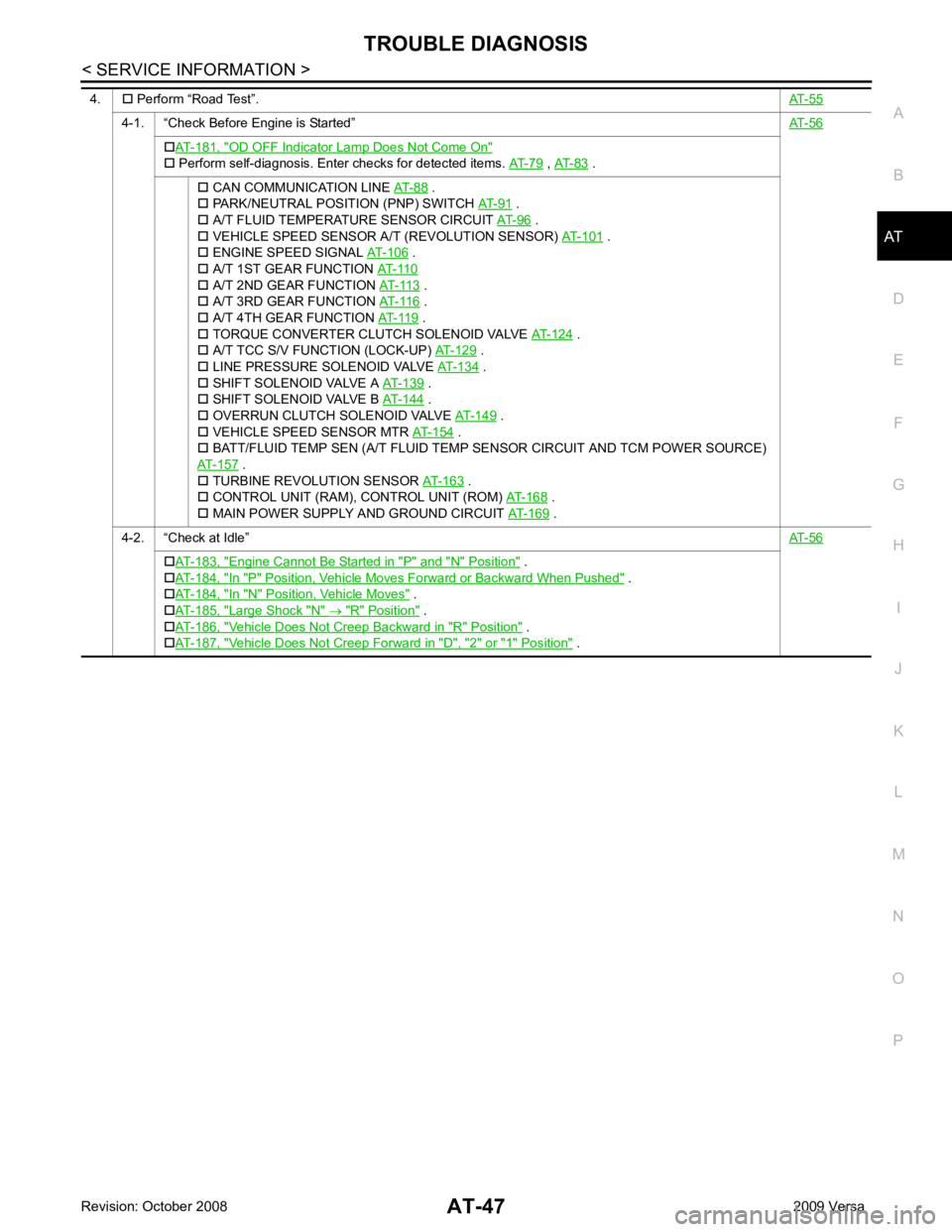
AT
N
O P
4.
�† Perform “Road Test”. AT-554-1. “Check Before Engine is Started”
AT-56OD OFF Indicator Lamp Does Not Come On "
,
AT-83 .
�† CAN COMMUNICATION LINE AT-88 .
�† PARK/NEUTRAL POSITION (PNP) SWITCH AT-91 .
�† A/T FLUID TEMPERATURE SENSOR CIRCUIT AT-96 .
�† VEHICLE SPEED SENSOR A/T (REVOLUTION SENSOR) AT-101 .
�† ENGINE SPEED SIGNAL AT-106 .
�† A/T 1ST GEAR FUNCTION AT-110 .
�† A/T 3RD GEAR FUNCTION AT-116 .
�† A/T 4TH GEAR FUNCTION AT-119 .
�† TORQUE CONVERTER CLUTCH SOLENOID VALVE AT-124 .
�† A/T TCC S/V FUNCTION (LOCK-UP) AT-129 .
�† LINE PRESSURE SOLENOID VALVE AT-134 .
�† SHIFT SOLENOID VALVE A AT-139 .
�† SHIFT SOLENOID VALVE B AT-144 .
�† OVERRUN CLUTCH SOLENOID VALVE AT-149 .
�† VEHICLE SPEED SENSOR MTR AT-154 .
�† BATT/FLUID TEMP SEN (A/T FLUID TEMP SENSOR CIRCUIT AND TCM POWER SOURCE)
AT-157 .
�† TURBINE REVOLUTION SENSOR AT-163 .
�† CONTROL UNIT (RAM), CONTROL UNIT (ROM) AT-168 .
�† MAIN POWER SUPPLY AND GROUND CIRCUIT AT-169 .
4-2. “Check at Idle” AT-56Engine Cannot Be Started in "P" and "N" Position " .
�† AT-184, " In "P" Position, Vehicle Moves Forward or Backward When Pushed " .
�† AT-184, " In "N" Position, Vehicle Moves " .
�† AT-185, " Large Shock "N" " .
�† AT-186, " Vehicle Does Not Creep Backward in "R" Position " .
�† AT-187, " Vehicle Does Not Creep Forward in "D", "2" or "1" Position " .
Page 53 of 4331
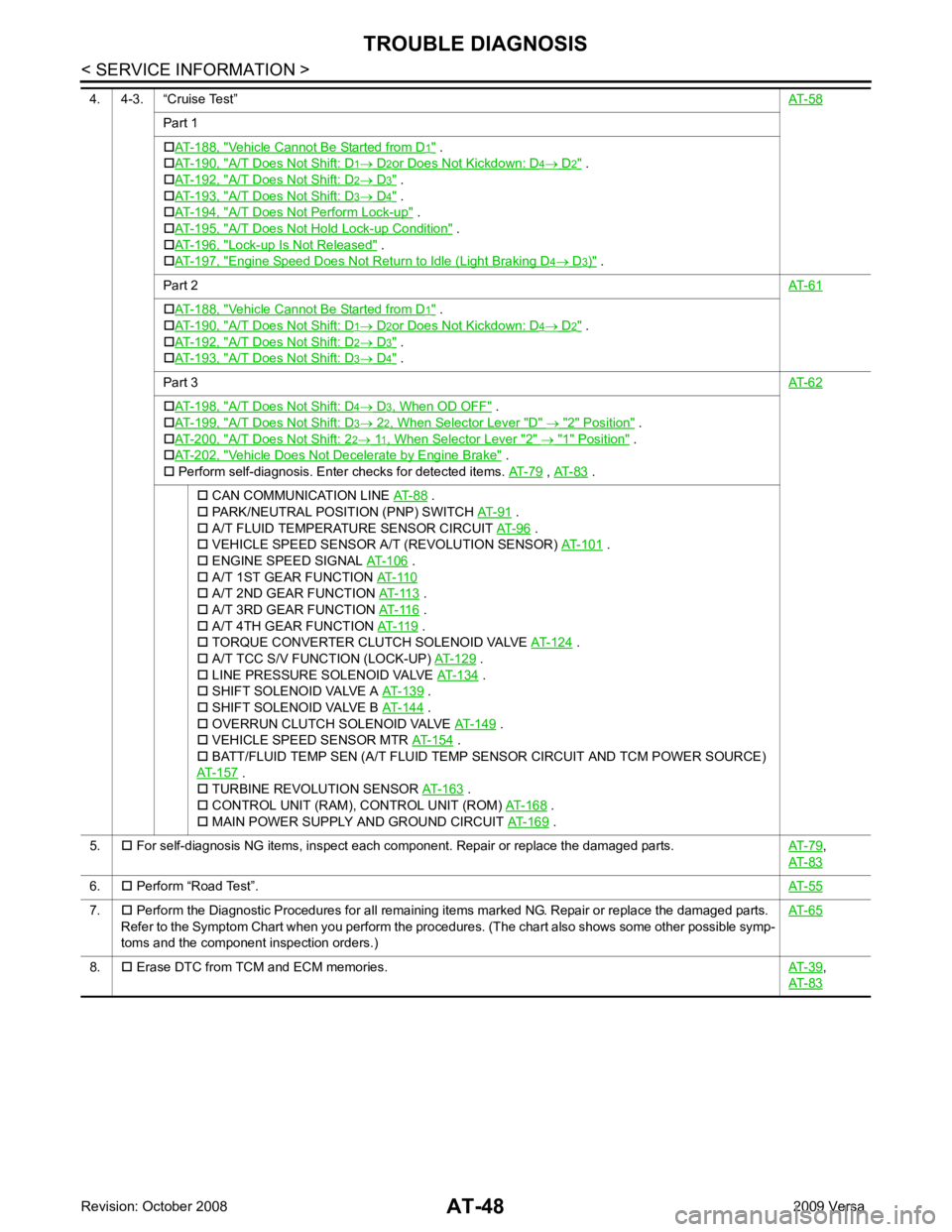
Part 1
�† AT-188, " Vehicle Cannot Be Started from D .
�† AT-190, " A/T Does Not Shift: D .
�† AT-192, " A/T Does Not Shift: D .
�† AT-193, " A/T Does Not Shift: D .
�† AT-194, " A/T Does Not Perform Lock-up " .
�† AT-195, " A/T Does Not Hold
Lock-up Condition " .
�† AT-196, " Lock-up Is Not Released " .
�† AT-197, " Engine Speed Does Not Return to Idle (Light Braking D " .
Part 2 AT-61Vehicle Cannot Be Started from D .
�† AT-190, " A/T Does Not Shift: D .
�† AT-192, " A/T Does Not Shift: D .
�† AT-193, " A/T Does Not Shift: D .
Part 3 AT-62A/T Does Not Shift: D " .
�† AT-199, " A/T Does Not Shift: D " .
�† AT-200, " A/T Does Not Shift: 2 " .
�† AT-202, " Vehicle Does Not Decelerate by Engine Brake " .
�† Perform self-diagnosis. Enter checks for detected items. AT-79 ,
AT-83 .
�† CAN COMMUNICATION LINE AT-88 .
�† PARK/NEUTRAL POSITION (PNP) SWITCH AT-91 .
�† A/T FLUID TEMPERATURE SENSOR CIRCUIT AT-96 .
�† VEHICLE SPEED SENSOR A/T (REVOLUTION SENSOR) AT-101 .
�† ENGINE SPEED SIGNAL AT-106 .
�† A/T 1ST GEAR FUNCTION AT-110 .
�† A/T 3RD GEAR FUNCTION AT-116 .
�† A/T 4TH GEAR FUNCTION AT-119 .
�† TORQUE CONVERTER CLUTCH SOLENOID VALVE AT-124 .
�† A/T TCC S/V FUNCTION (LOCK-UP) AT-129 .
�† LINE PRESSURE SOLENOID VALVE AT-134 .
�† SHIFT SOLENOID VALVE A AT-139 .
�† SHIFT SOLENOID VALVE B AT-144 .
�† OVERRUN CLUTCH SOLENOID VALVE AT-149 .
�† VEHICLE SPEED SENSOR MTR AT-154 .
�† BATT/FLUID TEMP SEN (A/T FLUID TEMP SENSOR CIRCUIT AND TCM POWER SOURCE)
AT-157 .
�† TURBINE REVOLUTION SENSOR AT-163 .
�† CONTROL UNIT (RAM), CONTROL UNIT (ROM) AT-168 .
�† MAIN POWER SUPPLY AND GROUND CIRCUIT AT-169 .
5. �† For self-diagnosis NG items, inspect each component. Repair or replace the damaged parts. AT-79 ,
AT-83 6.
�† Perform “Road Test”. AT-557.
�† Perform the Diagnostic Procedures for all remaining items marked NG. Repair or replace the damaged parts.
Refer to the Symptom Chart when you perform the procedures. (The chart also shows some other possible symp-
toms and the component inspection orders.) AT-658.
�† Erase DTC from TCM and ECM memories. AT-39 ,
AT-83
Page 56 of 4331
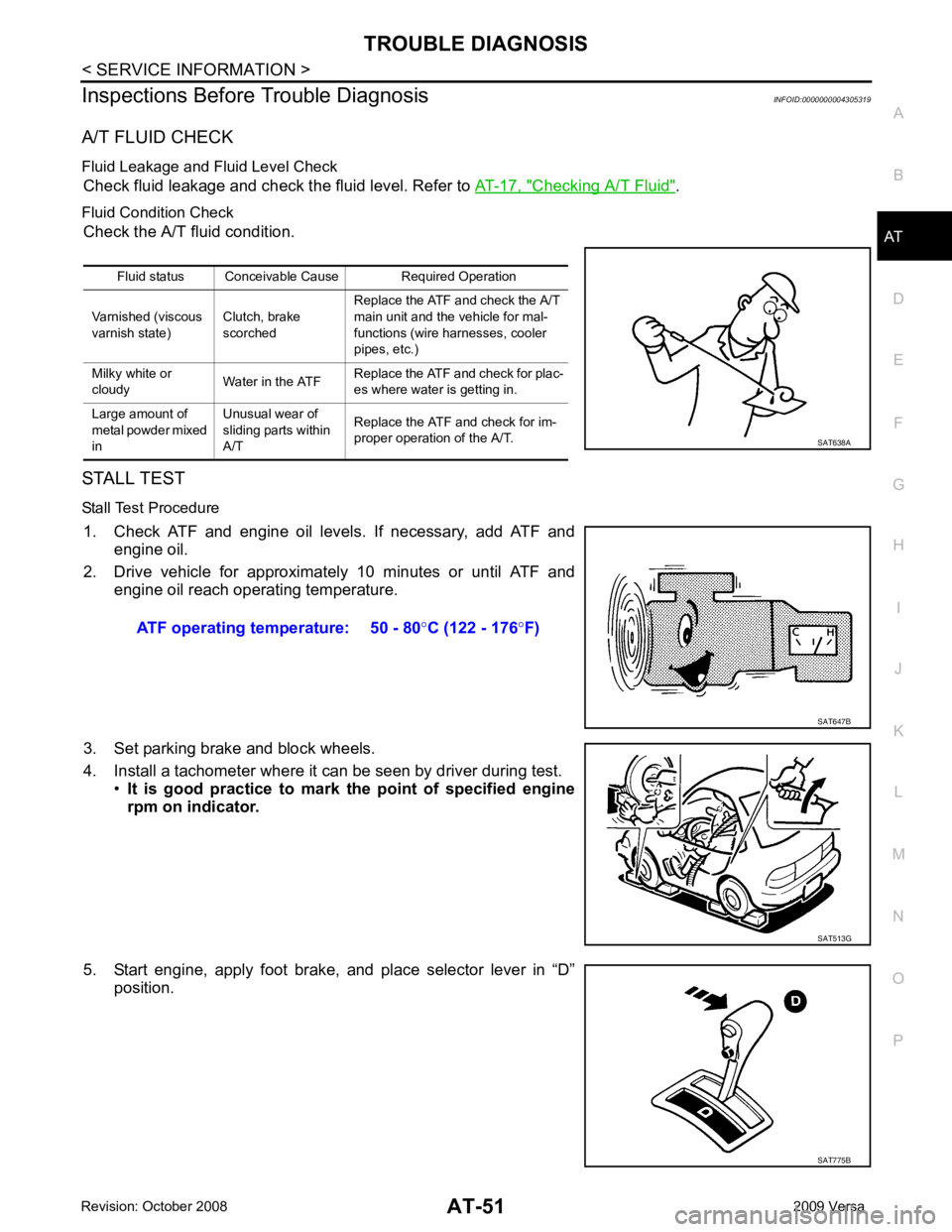
AT
N
O P
Inspections Before Trouble Diagnosis
INFOID:0000000004305319
A/T FLUID CHECK
Fluid Leakage and Fluid Level Check Check fluid leakage and check the fluid level. Refer to AT-17, " Checking A/T Fluid " .
Fluid Condition Check Check the A/T fluid condition.
STALL TEST
Stall Test Procedure 1. Check ATF and engine oil levels. If necessary, add ATF and engine oil.
2. Drive vehicle for approximately 10 minutes or until ATF and engine oil reach operating temperature.
3. Set parking brake and block wheels.
4. Install a tachometer where it can be seen by driver during test. •It is good practice to mark the point of specified engine
rpm on indicator.
5. Start engine, apply foot brake, and place selector lever in “D” position.Fluid status Conceivable Cause Required Operation
Varnished (viscous
varnish state) Clutch, brake
scorched Replace the ATF and check the A/T
main unit and the vehicle for mal-
functions (wire harnesses, cooler
pipes, etc.)
Milky white or
cloudy Water in the ATFReplace the ATF and check for plac-
es where water is getting in.
Large amount of
metal powder mixed
in Unusual wear of
sliding parts within
A/T Replace the ATF and check for im-
proper operation of the A/T. SAT775B